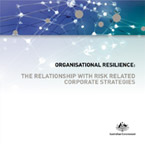 Australian Government
Australian Government
Overview: This report seeks to identify the value of the organisational resilience approach for the management of strategic and operational risk. It aims to do this by distinguishing it from other established strategies, including management systems, commonly adopted by business for risk management and other purposes. It is principally focused on for profit private sector organisations that face disruption risk challenges. However, the themes and concepts covered in this paper are of relevance to all organisations. While focused on the benefits for business, all Australian organisations are able to substantially benefit from an understanding of, and efforts to achieve, organisational resilience.
The report does not seek to exhaustively catalogue each available strategy, system or standard. However, to articulate the benefits of an organisational resilience approach it is useful to compare it to the strengths and limitations of some commonly adopted corporate strategies.
Three concepts of organisational resilience include ‘effective business-as-usual’ capability, ‘ability to change and adapt’, and ‘ability to shape the environment’. They have been identified through previous research commissioned
by the Commonwealth Attorney-General’s Department on Australian CEO perspectives on organisational resilience.
This document provides a synopsis of these three concepts and contrasts them with several common corporate strategies. It highlights key behavioural attributes of an organisational resilience approach not typically found in other strategies.
The report concludes that while established management practices are useful and support resilience, complex risk landscapes characterised by elaborate global supply chains, regulatory uncertainty, financial instability and information technology dependency require an enhanced level of organisational agility. Critically, the organisational resilience approach (which seeks to engender a more organic capacity in businesses) builds upon, and extends beyond, existing strategies for the management of unforeseen risk.
